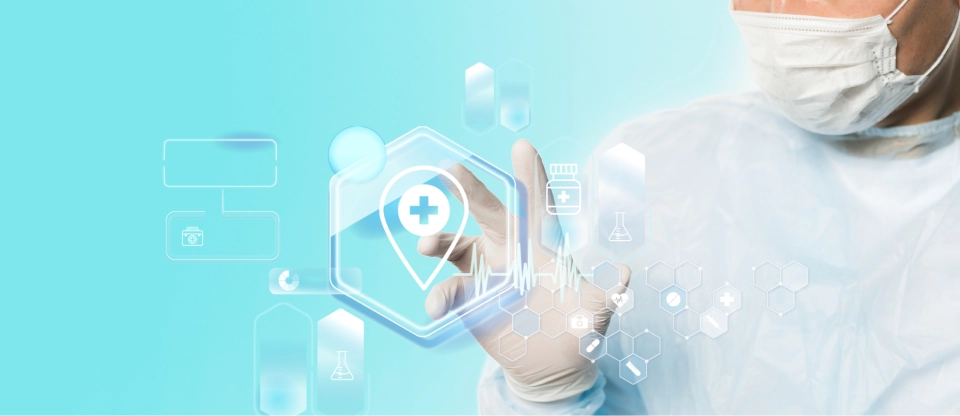INTRODUCTION
The threat environment looms large over the healthcare sector
In 2022, more than 590 healthcare organizations experienced a data breach at an average cost of $4.35 million per event. Data breaches in 12 healthcare organizations resulted in the loss of one million records, and a further 13 data breaches exposed between 500,000 and one million records. Most data losses were caused by cyber attacks against health insurance plans, with additional attacks coming via business associates, healthcare clearinghouses, and providers.
Healthcare organizations are being targeted daily by international hacking groups to steal valuable personal health record (PHR) data to be sold for profit on the dark web and other illicit marketplaces. In response, insurance providers have mandated that healthcare operators incorporate third-party risk management, robust cyber security protocols, and data governance best practices.
The Health Insurance Portability and Accountability Act (HIPAA) was signed into law in 1996 and has become the most significant legislation governing patient privacy and the use, transmission, and storage of personal health information (PHI). Healthcare organizations and third-party vendors are working zealously to deliver HIPAA-compliant cloud software applications to reduce the opportunity for cyber criminals to access organizational data.
However, there has been an exponential rise in cyber crimes and threats to PHI over the last few decades. How do you maintain HIPAA compliance in software development for web and mobile applications?
In this article, you will learn what HIPAA compliance is for healthcare software development partners and what steps to take to build custom HIPAA-compliant software solutions.
HIPAA
What does HIPAA compliance mean for healthcare software development partners?
HIPAA is the most critical and substantial privacy regulation governing the US healthcare industry.
Let us take a closer look at the three pillars of HIPAA compliance.
- Confidentiality: Personal health information must only be shared in approved methods with HIPPA-compliant entities.
- Integrity: Data must remain preserved and unaltered, whether intentionally or unintentionally.
- Access: All stakeholders in the community healthcare matrix must have proper and timely access to personal health records.
The Office for Civil Rights (OCR) is the primary federal agency protecting patient privacy rights. During 2021, the OCR received over 34,000 complaints of alleged HIPAA and HITECH violations—a 25% increase from the previous year.
By 2023, the healthcare industry was the most fiercely targeted by cyber criminals with large-scale hacking operations. On February 17th, 2023, the United States Health and Human Services OCR released two executive reports to Congress focused on healthcare data breaches, HIPAA compliance, and the evolving cyber security threat environment that healthcare providers face.
“The healthcare industry is one of the most diverse industries in our economy, and OCR is responsible for enforcing the HIPAA Rules to support greater privacy of individuals’ protected health information.” said OCR Director Melanie Fonte. “We will continue to provide guidance and technical assistance on compliance with the HIPAA rules, as well as a vigorous enforcement program to address potential HIPAA violations.”
HIPAA compliance, which can be achieved through healthcare web development, is essential for healthcare organizations to manage risks, reduce costs, and realize their full potential as business units. These recent reports to Congress outline a pervasive threat environment that underscores the need for providers to complete strategic investments to ensure all software solutions used are HIPPA compliant.
HIPAA data privacy reports delivered to the U.S. Congress
The 2021 Report to Congress on HIPAA Privacy, Security, and Breach Notification Rule Compliance outlines the number of HIPAA complaints received, the methods the government used to resolve those complaints, the number of complaints initiated internally through the OCR as well as the outcome of each case that was reviewed.
The Annual Report to Congress on Breaches of Unsecured Protected Health Informationoutlines the threat environment healthcare providers are facing. It outlines the number and scope of breaches of unsecured PHI.
This report also identifies best practices for improving compliance with key HIPAA Security Rule provisions such as:
- Risk analysis and risk management processes.
- Information system activity reviews.
- Audit controls and access controls.
Data breaches are more common than ever. It is time to improve your organizational security.
PROVISIONS
Key HIPAA provisions for healthcare software development
Under HIPAA, all physicians, mental health providers, pharmacies, and healthcare organizations with access to personal health information are considered “covered entities” and are subject to the law’s reporting, disclosure, and documentation standards.
‘If a custom healthcare development company interacts with a solution that gathers and processes personal identifiers of patients, HIPAA standard applies to the software provider.’
Under HIPAA guidelines, every organization considered a covered entity or business associate must comply with the law. Business associates are defined under the law as a person or company that offers services to the covered entity, resulting in the disclosure of personal health information.
“All software firms in the healthcare industry that keep, share, or simply have access to identifiable health information of patients must be HIPAA compliant.”
Privacy rule
This rule was designed to allow personal health data to move through the community health network without allowing fraud to impact patients negatively. It grants patients the right to examine, receive copies, and require changes to their health records.
Security rule
The security rule sets the standard by which covered entities generate, receive, use, and maintain electronic health records. Under this rule, entities must provide “adequate administrative, physical, and technological protection to maintain the confidentiality, integrity, and security” of ePHI.
Compliance rule
The enforcement rule stipulates how the Department of Health and Human Services (HHS) will enforce HIPAA and what penalties will be rendered for non-compliance.
Notification regulations
This section requires HIPAA-covered entities to immediately disclose the unauthorized breach of any electronic health data.
General rule
It establishes the rules concerning interoperability in healthcare IT solutions. It alters numerous HIPAA privacy, security, and enforcement rules, making it more challenging to dodge breach reporting, expanding non-compliance responsibility to business partners, and imposing additional privacy limits for using the PHI.
“Healthcare software used to collect, amass, store, transmit, and operate PHI must comply with HIPAA and adhere to its laws and regulations. However, if an application does not handle protected health information, it is excused from HIPAA compliance.”
There will be consequences if the software violates any HIPAA compliance restrictions. Thus, it’s critical to understand how to make a healthcare software program HIPAA-compliant.
COMPONENTS
The key components of HIPAA-compliant software
The absolute best compliance software is the solution that is custom-designed to meet the needs of your healthcare organization. There is no one-size-fits-all solution, and every organization needs to select a custom medical software solution that will provide the utility they need to meet their organization’s unique compliance obligation.
Security risk assessment tools
HIPAA compliance requires regular security risk assessments according to federal regulations. An assessment is a baseline snapshot of your organization’s security and privacy practices with regard to HIPAA compliance obligations.
Security and data governance playbooks
After completing a needs analysis, your organization will be able to use compliance software to develop a new plan to mitigate the risks that were uncovered. Following your plan is essential to reducing your risk, or else your organization may suffer fines or be slapped with criminal penalties for failure to comply.
Policies and procedures
Your new software will allow your management team to create governance structures to ensure your employees, vendors, and partners implement your policies and procedures to limit compliance risk. Your software will help to streamline these practices so that many of these requirements are fulfilled using automated processes.
Documentation tools
One of the most time-consuming aspects of HIPAA compliance is documenting measures taken to fulfill the necessities of the law. Documentation tools make it easier to access, update, and share critical documents with regulators and other stakeholders across the healthcare matrix.
Business associate management
Before sharing data with third-party vendors, your organization must execute contracts known as business associate agreements to reduce liability if a supply chain partner experiences an attack leading to a data loss event.
Interested in HIPAA-compliant software development?
BLOCKCHAIN
Leveraging blockchain technologies to support HIPAA compliance
Due to the transparency and interoperability it brings, blockchain technology is emerging as a strong choice to build HIPAA-compliant solutions.
Healthcare information security protocols will leverage some other key features of blockchain technology, such as:
- Decentralization: Blockchain solutions remove the need to rely on semi-trusted third-party entities that pose a significant risk due to supply chain cyber-attacks.
- Pseudonymity: Blockchain architecture, by design, protects identities and creates unique opportunities for expanded access management.
- Autonomy: Across the blockchain networks, users maintain access to their PHI and decide who and when to share information.
- Auditability: All records are securely maintained for posterity across blockchains, making it easier to verify compliance.
- Incentivization: The collective and open-source nature of blockchain solutions makes it easier for diverse stakeholders to develop HIPAA-compliant solutions in tandem with each other.
Blockchain is an emerging technology like artificial intelligence, machine learning, and business process automation that is being applied to deliver innovative healthcare product development solutions across the industry.
Blockchain networks offer a unique means of seamlessly preserving and exchanging patient data and moving it between hospitals, diagnostic laboratories, pharmacy firms, and physicians without compromising confidentiality or integrity and ensuring proper access along every touch point in the healthcare matrix.
Software development experts believe that blockchain solutions will be used shortly to identify risk management focus areas more quickly before they lead to adverse outcomes for medical service providers. Blockchain technology offers more robust performance, security, and transparency of data exchange, making it easier for healthcare organizations to share information and maintain HIPAA compliance safely.






